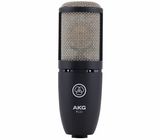I have successfully used this condenser microphone for recording voice overs and as part of a mic kit for recording a grand piano.
In the case of vocals, it allows recordings that accurately reproduce what you would have heard if you were present during the recording session. No detail is lost from the source material. The bass response is great when recording male vocals. The frequency reponse chart indicates that it should also work well for female vocals (only tested male vocals).
In the case of piano recording, the P220 is ideal as part of a coincident pair with a P170 condenser (using P220 to pick up bass end, P170 for treble end).
The microphone does not require a lot of gain like small-diaphragm condensers or dynamic mics to sound right and pick up the slightest of details. I do not recommend a very high gain with this mic however, as the sound will be very tin can-ish. It worked fine with the mic pres I have in my MG10XU mixing console or UR22 Mk ii recording interface (both D-PRE).
The included spider shock-mount is very sturdy and holds the microphone still without any wobbling (the mount screws in to the built-in threads on the bottom side of the mic). I recommend a strong stand with this mic, for example a K&M 232BK if buying a table-top stand as the mic and shock-mount assembly is on the heavy side. Try to avoid flimsy stands with this mic.
I did not spend a lot of time trying the HPF and pad switches, but from my testing they work well. My usual setting is to keep HPF off (using the one on the mixing console if needed) without any padding (again using the one on teh mixing console if needed). The built-in switches will work fine if using a recording interface with fancy mic pres.
On the whole, I recommend this microphone to anyone looking for a high quality but budget friendly mic for recording vocals for interviews, or voice-overs as well as singers.

